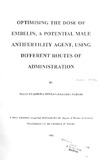| dc.description.abstract | Reproduction is a physiological process which involves the act of mating between
two members of one species and of opposite sex with consequent production of
offspring. At human level this physiological process is controlled by many factors
such as behavior, societal set up, economy and politics. One of the main ways
of regulating sexual reproduction and therefore population growth in most of the
groups has been through the use of contraceptives. However, most of the
contraceptive methods available have been focused on the female.
In the recent past a lot of effort has been directed towards developing a
contraceptive with suitable and acceptable male fertility regulating properties. One
of the promising approaches to obtaining this male fertility-regulating agent has
been in use of the higher plant extracts. Indeed some plants of the Myrsinaceae
family have been known to have compounds (mainly benzoquinones) with male
fertility-regulating properties. One such compound isolated from these plants is
ernbelin. Results obtained with embelin so far indicate that it alters the histology
of the testis and reduces the weight of the accessory sex glands, sperm count and
their motility as it interferes with fertility in male rabbits by lowering plasma
testosterone levels.
This project was aimed at investigating the minimum effective and optimum dose
of embelin required to regulate fertility in male rabbit using three routes of
administration namely subcutaneous, intramuscular and oral. In the latter case
embelin was administered as a suspension as well as in tablet form Plasma
testosterone concentration was used as an indicator for fertility potential. The
dose of embelin used was varied from 0.5 - 70 mg per kg of body weight Plasma
testosterone concentration was measured by radioimmuno assay (RIA) technique.
Results indicate that when embelin was administered intramuscularly a minimum
dose of 5.0mglkg of body weight was observed to lower plasma testosterone levels
from a mean pre-treatment level of 8.32 ± 0.4 nmollL to mean treatment phase
level of 4.8 ± 1.2 nmol/L. This represented a 54 per cent decline in plasma
testosterone levels. For the oral route a slightly higher than that used for the
intramuscular route but minimum effective dose of 10.0 mg/kg of body weight
was required to cause a significant (P<0.001)lowering of plasma testosterone from
mean pre-treatment level of 12.2. ± 0.70 nmol/L to 6.0 ± 2.0 nmol/L during treatment. This was a 63 percent decline in the hormone levels. But when embelin was administered orally as a tablet of 50.0-mg base per kg of body weight there was slightly less lowering of plasma testt!!9ne than when it was administered as a suspension The testosterone levels declined' from mean pre-treatment levels of 5.5 ± 0.65 nmol/L to mean treatment levels of 47 ± 1.5 nmol/L this being a 40 percent decline.
On administering embelin subcutaneously a minimum effective dose of 20.0 mg per kg of body weight was required to cause a significant (P< 0 01) lowering of plasma levels from mean pre-treatment levels of 22.6 ± 1.30 nmol/L to mean treatment levels of 19.8 ± 0.3 nmol/L representing a 12.4% decline.
The decline in testosterone levels when embelin was administered either
intramuscualarly or as a suspension orally was almost instantaneous. But when
administered as a tablet orally or is an injection subcutaneously the decline in the
hormone levels was gradual. For the intramuscular route the effect of embelin in
lowering testosterone levels was directly related to the dose of embelin administered implying that this effect ofembelin was dose related.
Higher doses of embelin than those of intramuscular route were required for
optimum effect when administered via oral route. This was perhaps due to the fact that some embelin was metabolised in the gastrointestinal tract before it was absorbed to get to the target organ where it was to exert its effect When administered as a tablet form the effect was gradual and not very pronounced, this would imply that embelin was not released fast enough and in high enough - concentrations to reach the site of action and-have instantaneous and pronounced effect.
The gradual lowering of testosterone levels observed when embelin was administered subsutaneously was perhaps due to the fact that embelin got accumulated in fatty tissues, where some of it may have been metabolised and thus reducing its concentration that would get into the target organ. This implies that the concentration reaching the target organ was not in high enough concentration to cause pronounced effect. It is important to note that in all cases on withdrawing embeltn the testosterone
concentration returned to normal levels after treatment implying that its effect was
temporary and hence reversible, this being a crucial property for any antifertility agent.
The observations made in the study indicate that embelin lowers plasma testosterone levels when administered at the right dose via the three major routes of drug administration. This lowering of testosterone levels is most likely the cause of antifertility effect observed when embelin is administered to the rabbit.
From the study it would appear that the best route of administering embelin would
be via the oral route. Although embelin was -required at higher doses when administered orally, the effect was almost: instantaneous Just like the intramuscular
route, despite the fact that no pain was inflicted on the animal when administering the drug Eventually the route would be economical as no medical staff or equipment would be "required to administer ernbelin. | en |

